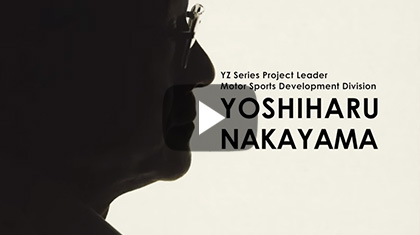A coffee table sat between the two men; there was a strange sense of anticipation in the air. Leaning back into the sofa, Yamaha team manager Keith McCarty slowly began to speak, asking Doug Henry sitting across from him if he would ride a 4-stroke machine for the next season. Those words he heard that day back in 1996 at the team manager’s home were something Henry had never expected.
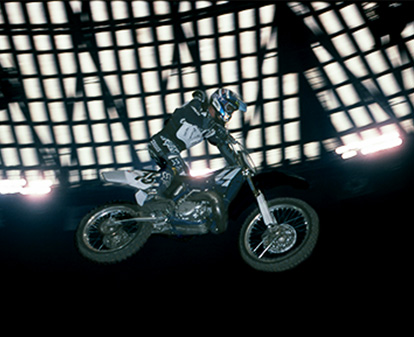 Until 1996, 2-strokes were the norm in Supercross.
Until 1996, 2-strokes were the norm in Supercross. “On a 4-stroke, I would do wheelies, go through the woods, ride with my buddies, they were just play-bikes [and not racing bikes]. I remember like it was yesterday. I went to Keith McCarty’s house, I sat on his couch to discuss what we were gonna do for the next year and that’s when he told me that Yamaha wanted me to ride the 4-stroke and my heart kinda sank. I had broken my back in 1995 [and] I really struggled with whether I should try the 4-stroke or not because I was having trouble trying to get back up to race pace. But I had won a race in ’96 and just felt like I was back. I was very skeptical [because I was used to riding 2-strokes and wanted to compete on the YZ250] and I couldn’t answer him right then and there; I had to think about it for a little while. ... When it came down to it, I said, ‘Let’s do it and do the best we can.’”
The 4-stroke bike Henry was entrusted with was the YZM400F (0WH2), a completely one-off, full factory machine. But, the regulations for the AMA Supercross and AMA National Motocross championships only allowed production-based models to compete, so why was the factory bike allowed to enter races? The reason was that Yamaha Motor Corporation, U.S.A. (YMUS) approached the AMA about making an exception for 4-strokes, and the organization made the radical decision to let the YZM compete.
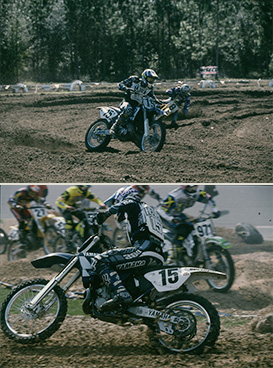 Doug Henry racing on the 2-stroke YZ250 in AMA Nationals (above) and at the Supercross round in Daytona (below) in 1996
Doug Henry racing on the 2-stroke YZ250 in AMA Nationals (above) and at the Supercross round in Daytona (below) in 1996 At the time, the state of California had just set quite stringent emissions regulations out of concern for the environment. Yamaha explained to the AMA that there was a real need for 4-stroke engines to be used in motocross due to their inherently lower emissions and proposed that 4-stroke factory motocross bikes be allowed to compete in AMA races for development purposes on a limited basis. Just three days later, the AMA approved the proposal; if it was a 4-stroke prototype for the purpose of developing a production model, a manufacturer could apply for entry and the machine would be allowed to compete for one season. In other words, the YZM400F had a one-year lease on life as an AMA-approved competition machine. In actuality, it was just a short eight months that ran from the season opener of the 1997 AMA Supercross series until the final round of the AMA Nationals.
At the time, AMA off-road motorcycle races had a 125cc and a 250cc class (both 2-stroke). The YZM400F would compete in the 250cc class in which 4-stroke models of up to 550cc were allowed to compete. Meanwhile, the Motocross World Championship had 125cc, 250cc and 500cc classes that were run as separate series and there were no 4-stroke displacement allowances, so Yamaha planned to have the YZM400F compete in the 500cc class.
At the start of the factory prototype’s development, Project Leader Masakazu Shiohara and the other team members were all experts in road racer development. Shiohara himself had only worked on 2-stroke models since joining Yamaha Motor, and he was a specialist that had designed several engines for YZR racers. The members had also never designed 4-stroke engines or worked on a motocrosser before. There was naturally concern as to whether engineers that specialized in designing 2-stroke road racers—the completely opposite kind of machine—could do the job well. In the end, however, starting completely from scratch and with their lack of preconceptions was largely why they ended up creating a revolutionary 4-stroke motocrosser.
From the beginning of development, it was already decided that the chassis would take on the dimensions of the YZ250. If the size of a 2-stroke 250cc machine was the target, making use of the YZ250’s already proven chassis would eliminate the need to build an all-new frame through trial and error. So the team mounted a TT250R engine in a YZ250 frame and tried the machine out, but it was simply too heavy to be used in competitive motocross.


 The YZM400F was entered in the 1997 500cc Motocross World Championship and the AMA Supercross series.
The YZM400F was entered in the 1997 500cc Motocross World Championship and the AMA Supercross series.They were at a dead end until one of the engineers on the development team, Kenji Tamura, made an interesting proposal. He took the cylinder head and camshaft of a YZF750 engine and sawed off the sections for a single cylinder. He then paired it to the cylinder of a TT250R engine (YZF bore: 72 mm; TT250R bore: 73 mm) using welding and putty to make a prototype 250cc engine. The engine revved up to 13,000 rpm and had power roughly between that of a 125cc and 250cc 2-stroke engine. When this prototype engine was mounted in a YZ250 frame, it ran unexpectedly well and weighed just under 110 kg—this could work! The team was no longer stumbling around in the dark and had found a light at the end of the tunnel to work toward with renewed determination.
Eventually, the YZM was given a displacement of 400cc with a bore × stroke of 95 mm × 56 mm. These specs were not chosen with a priority on performance but to keep the engine height to a size that would fit in the YZ250 frame. However, this raises a question: if the end-goal was a machine for competing in the Motocross World Championship, why didn’t they take the displacement all the way up to the 500cc limit allowed? There were two reasons.
First of all, chasing power alone would be meaningless if it made the machine too heavy, and the team’s calculations had indicated that the optimum balance of power and weight lay with a displacement of somewhere around 400cc. The other reason was in the equation 250 × 1.6 = 400. Due to the characteristics of a 2-stroke engine, some of the fresh charge that is expelled from the cylinder into the expansion chamber is then drawn back into the cylinder. This is said to be what gives 2-stroke engines 1.6 times the power of a 4-stroke per unit of displacement. This led to the calculation that making a 4-stroke engine with power equivalent to a 250cc 2-stroke would require 1.6 times the displacement, which comes to 400cc. This was the same displacement setting as the All Japan Road Race Championship’s TT-F3 class.
As development for the YZM400F factory machine steadily progressed, a project to develop another machine was also underway. That machine would eventually debut as the YZ400F production model. Before he became its Project Leader, Yoshiharu Nakayama was working in the Motor Sports Development Division. When the YZ Group was integrated into the department, it was decided that 4-stroke models would be added to the existing 2-stroke lineup. Because a large number of departments are involved in production model development, there are also a large number of accompanying constraints, but since the Motor Sports Development Division is for racer development, this reorganization provided a good environment for moving projects forward.
“In those days, the YZ models were undergoing full redesigns on a three-year cycle, so the timing was ‘96 and ‘99. This meant that the ‘98 models offered a good opportunity to try out new things,” says Nakayama. “In a typical project, the marketing and product planning departments would make requests for a new model, but for that bike, we in development made our own strong request to them for a 4-stroke YZ motocrosser and we listed it on the overall schedule as a ’98 model. Nothing had really taken shape yet, but we figured we could probably get it done in time.”
Although it was his first time developing a motocrosser, Nakayama had many years of experience designing 4-stroke engines. The methods for the YZ400F would be the same as the YZM400F; they would stick to the simple concept of making a 4-stroke engine for a YZ250 frame. To minimize the height of the cylinder head as much as possible, the DOHC engine adopted a 5-valve format and the bore × stroke of the YZ400F was made 92 mm × 60.1 mm as opposed to the YZM400F’s 95 mm × 56 mm spec. Also, the frame for YZ400F was a model-specific design rather than replicating the one on the factory machine.

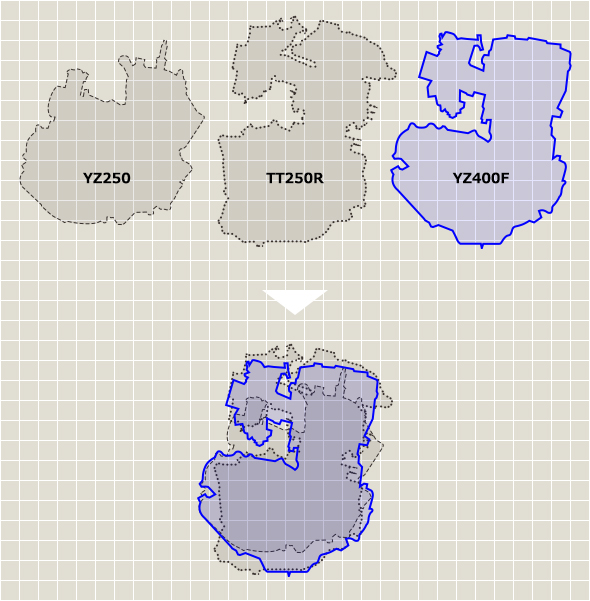
“In order to meet the deadlines for the production model’s manufacturing schedule, we didn’t have time to wait for feedback from the factory bike,” says Nakayama. “Because production models come with numerous conditions like costs, reliability and manufacturing efficiency, we couldn’t do things in the same way. On top of that, we also had to conduct simultaneous development of the WR400F as the sister model to the YZ400F. For a project like this to be successful, we have to be able to expect a certain volume of production in order to get a return on capital investment, etc. So, initially we pushed through a production plan of 3,000 units for the YZ400F and 6,000 for the WR400F.”
At the end of 1996, Doug Henry, Andrea Bartolini and Peter Johansson came to Japan to test the YZM400F factory bike. Having a father who worked for helicopter maker Sikorsky Aircraft Corporation and he himself educated in tools and machining, Henry was amazed by the mechanical beauty of the new factory machine sporting exotic materials like titanium and carbon fiber throughout. On the other hand, the testing for the YZ400F took place in the United States with representatives from Europe present as well. Nakayama recalls it being less of a test and more of a promotional event meant to sell people on the new production model.
“No one believed us when we told them we were developing a 4-stroke production motocrosser, and the more knowledgeable about motocross they were, the more skeptical they became. Even in the U.S., they thought it would be like a 400cc version of the TT500, so we took a YZ400F prototype to America to get them to actually ride it themselves before passing judgement. We ran tests at places like Carlsbad, Glen Helen Raceway and Los Angeles County Raceway, and the response was quite good; people were really surprised. We had also invited Stéphane Peterhansel over from Europe. I remember his eyes were wide with astonishment the moment he took off his helmet after his test ride and shouted, ‘That was a surprise!’”
When the 1997 AMA Supercross season began, Henry was competing on the 2-stroke YZ250. Because there were still a few problems with the settings for the carburetor accelerator pump on the factory YZM400F, the decision was made to not race the bike until the second half of the AMA Nationals season. The racing world was gossiping that there was no way a 4-stroke could cut it in Supercross. But Henry and Yamaha, who knew the potential of the 4-stroke factory bike better than anyone, were secretly planning to enter it in the Supercross series.
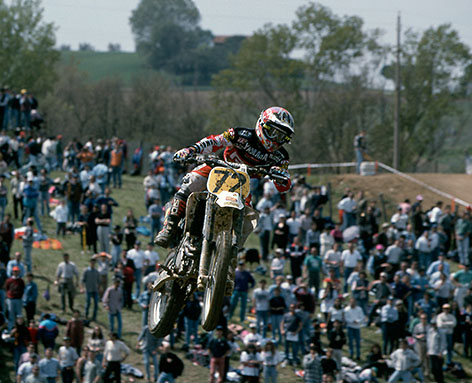 Riding the YZM400F in the 500cc Motocross World Championship, Andrea Bartolini took a win at the Italian GP.
Riding the YZM400F in the 500cc Motocross World Championship, Andrea Bartolini took a win at the Italian GP.It was only one week before the last round of the Supercross championship in Las Vegas that the news broke about the YZM400F entering the event. Henry had led the point standings from the start of the season and the YZ250 had been performing well, so there was no point in risking a switch to the YZM400F. But, after breaking his hand and falling out of contention for the title mid-season, Henry now had nothing to lose.
The approaching final round of the season would be the first and only time that the YZM would compete in Supercross under the AMA’s one-year exception. In Europe, Andrea Bartolini had already ridden the YZM400F to its first GP victory in Italy. There was no doubt that things were turning in their favor and Las Vegas is a place where everyone comes with high hopes of winning. There was certainly no better place to gamble on success for the YZM.
It was May 17, 1997 at Sam Boyd Stadium in Las Vegas. Of all the venues for the AMA Supercross series, the course set up in this stadium was one of the smallest. The hard-packed track made bikes slip easily, there were successive tight turns and the straights were short. The crowd thought there was nothing advantageous at all for Henry on the 4-stroke, but when the racing started, he instantly erased the doubts in their minds.
Henry took the holeshot to grab the lead and began flying around the track right from the first lap, opening up a more than 2-second gap to his pursuers. In the qualifying heat race, Henry had battled with Jeff Emig and the lead had changed hands with almost every lap. But in the main event, no one seemed to be able to catch Henry. It was the common belief that the way to race a 4-stroke on the dirt was to keep the throttle pinned and take the outside lines through the corners, but Henry was doing just the opposite, staying glued to the inside line through each turn. He was taking advantage of the machine’s great traction as well as its quick-revving character.
Henry’s rhythm wasn’t thrown off in the whoops and he was able to hold a straight line through them. It was a perfect example of how a 4-stroke engine could help stabilize the chassis in motion due to having less torque fluctuation compared to a 2-stroke. It was thought that Supercross demanded an engine with the sharp response that only a 2-stroke could give, but watching Henry’s ride was actually making the weak points of the 2-strokes more apparent instead. For example, when going full throttle while running over a bump, the 2-stroke’s sudden burst of power tended to throw the rear wheel sideways, or when opening the throttle to accelerate, the power would cause the rear wheel to spin instead of grip. In contrast, Henry’s 4-stroke had none of these tendencies.
 Doug Henry rode the YZM400F to win the final round of the 1997 AMA Supercross series in Las Vegas.
Doug Henry rode the YZM400F to win the final round of the 1997 AMA Supercross series in Las Vegas.It was only when he cut back on the throttle for an instant during jumps that there would be a break in the robust hum of the 4-stroke’s exhaust note. On each lap, the YZM400F easily cleared the triple, and by halfway through the main event it had won the awe and admiration of all the fans watching. No one was doubting the performance of the 4-stroke machine anymore. When Henry took the checkered flag after 20 laps, he and the YZM400F took the first win on a 4-stroke in AMA Supercross history. Leading every lap of the race, this perfect win had proven the machine’s awesome potential.
Henry recalls: “I remember getting to Vegas with the 4-stroke for its debut, and Mike Kiedrowski walking by laughing and saying, ‘Do you really think you’re gonna qualify on that thing?’ But I knew that we could win during the tests in Carlsbad that Thursday. Once we got the carburetion set up right, I knew we had a really good bike.”
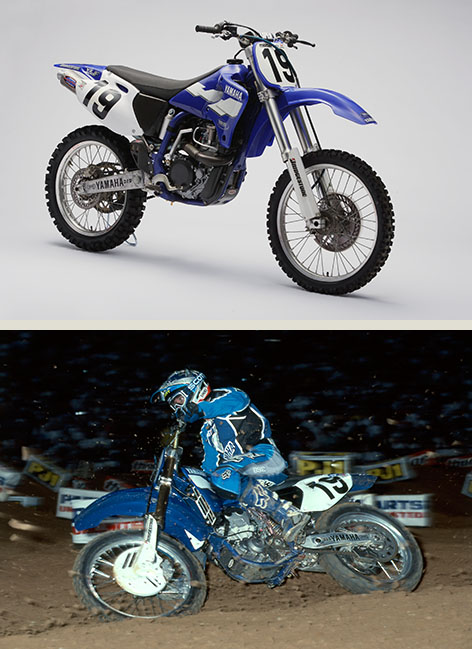 In 1998, Doug Henry rode the YZ400F to four 3rd-place finishes in AMA Supercross and won five AMA 250cc Nationals to be crowned class champion.
In 1998, Doug Henry rode the YZ400F to four 3rd-place finishes in AMA Supercross and won five AMA 250cc Nationals to be crowned class champion.Every time the YZM400F displayed its competitiveness, it sparked hopes and anticipation in motocross riders around the world for the production version that was sure to follow. The topics of conversation were if the prototype was already being tested or if the production bike would be out in a year or two. But, Yamaha made sure motocross enthusiasts would only have to endure a short wait.
Just three months after the factory machine made its racing debut, the YZ400F 4-stroke production motocrosser was unveiled in June 1997. Although they would have to wait until that year’s autumn motor shows to see the WR400F enduro bike, the dramatic introduction of the production model so soon after the factory bike’s epic first victory was more than enough to take motocross fans by surprise. They now had the production version of the factory machine right before their eyes. The time for dreaming what the bike would be like was already gone, because Yamaha had replaced it with the next dream: getting to ride one as soon as possible.
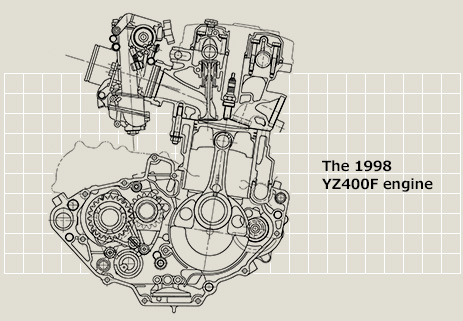
Although the AMA agreement for factory machine participation was just for that 1997 season, Henry’s relationship with 4-stroke machinery would continue. In 1998, he switched to the YZ400F production model and scored four 3rd-place finishes in Supercross and five overall wins in the AMA 250cc Motocross Championship to take the title.
“The prototype YZM400F was light and powerful and the production YZ400F had even better handling. [So it’s hard to say which was better.] But, it was a combination of seat time on the 4-stroke bike and being stronger and training more that helped win the title,” says Henry.
Every time the thundering roar of engines fills the stadium at Supercross events, it brings back memories of that incredible night in Las Vegas when Doug Henry made a bold gamble no one thought he could win. If he hadn’t won the jackpot that night on May 17, 1997, today’s era of off-road racing with 4-strokes may not have dawned as quickly as it did.
The move to 4-strokes that Yamaha pioneered soon sent shockwaves around the world. With the YZ250F that debuted in 2001, then the bored-out and more competitive YZ426F and later the even bigger displacement YZ450F, the motocross world was soon dominated by by Yamaha 4-stroke machines.
With its development of the YZM400F factory machine and YZ400F production motocrosser, Yamaha overturned the long-held belief of the industry (and the sport of Supercross) about 4-stroke motocrosser capability and competitiveness. This pioneering of 4-stroke machinery in the category and the subsequent advances made possible by starting development with premier-class off-road models would lead to substantial growth in the number of off-road enthusiasts worldwide.

The First Winner of an AMA Supercross on a 4-stroke
At the final round of the 1997 AMA Supercross season, the YZM400F ran under special rules in what would be its first and only chance to race in the series. People thought the track didn’t favor a 4-stroke, but Doug Henry erased the spectators’ doubts right from the beginning of the race.